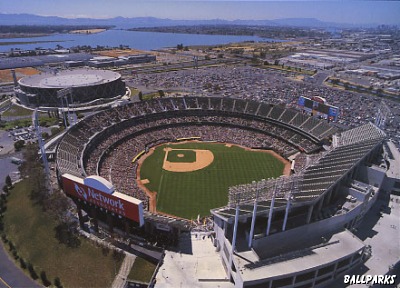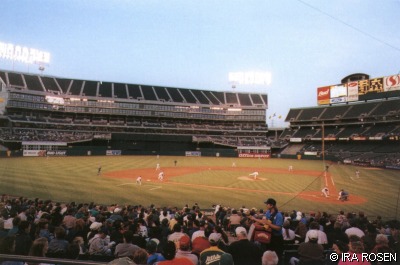Oakland-Alameda County Coliseum
formerly UMAX Coliseum, Network Associates Oakland, CaliforniaTenants: Oakand Athletics (AL); Oakland Raiders (NFL) Architect: Skidmore, Owings & Merrill (1966); HNTB (1996). Oakland Athletics tickets:
Location: Center field (NE), San Leandro Street and Southern Pacific Railroad tracks; third base (NW), 66th Avenue; home plate (SW), Nimitz Freeway (I-880); first base (SE), Hegenberger Road. Dimensions: Foul lines: 330; power alleys: 378 (1968), 375 (1969), 372 (1981), 375 (current); center field: 410 (1968), 400 (1969), 396 (1981), 397 (1982), 400 (1990); backstop: 90 (1968), 60 (1969); foul territory: largest in majors. Fences: 8 ft. (plywood, 1968); 10 ft. (canvas over plywood and plexiglass, 1981); 8 ft. (1986); 8 ft. in left, center and right fields, 16 ft. in the power alleys (1996).
On a stretch of land near an Oakland freeway, Alameda county broke ground for the Coliseum and Sports Arena. Completed in 1966 with only the Oakland Raiders as tenants, the $25.5 million complex lured the Athletics from Kansas City in 1968 and the Warriors from San Francisco in 1971. Although the Coliseum held 48,219 spectators for baseball, the Aís didnít draw 1 million fans in a season until 1973, reaching that level only twice in their first 13 years in Oakland. The Coliseum has been home to some of the biggest names in baseball. Jim "Catfish" Hunter, Reggie Jackson and Rollie Fingers were A's teammates in the early 1970s. Dick Williams, Alvin Dark, Chuck Tanner, Billy Martin, and Tony La Russa were all managers in Oakland. In the late-1980s the Coliseum became home to another group of Oakland stars: Rookie of the Year winners Jose Canseco, Mark McGwire, and Walt Weiss helped produce three consecutive American League titles beginning in 1988 and a World Series title won in the "Bay Bridge" series sweep against the San Francisco Giants in 1989. In the Coliseum, "Catfish" Hunter pitched a perfect game in 1968 and Rickey Henderson broke Lou Brockís stolen base record in 1991.
To satisfy a provision in the 1995 agreement to bring the Raiders back to Oakland, after a 12-year stint in Los Angeles, a Coliseum renovation project began in November 1995 and proceeded through the 1996 baseball season. Although the renovations were projected to cost $100 million, the cost eventually ballooned to $200 million. The A's played their first few home games of the 1996 season in Las Vegas while work crews installed new seats in the Coliseum. The project has removed the outfield bleachers but added two 40,000-square-foot clubs, 22,000 seats, 125 luxury suites, a 9000-square-foot kitchen, two new color video boards and two matrix scoreboards. In September 1997 UMAX Technologies, a tiny Bay Area subsidiary of a Taiwanese computer hardware maker, bought the naming rights to the Coliseum. The deal would have given Oakland, Alameda County and the Raiders NFL franchise more than $17 million over 10 years. However, a dispute arose and a 1998 court decision reinstated the stadium's original name. Later that year, Network Associates agreed to pay $5.8 million to put their name on the stadium for 5 years. In 2003, the deal was renewed for another 5 years at a cost of $6 million. In 2004, Network Associates was renamed McAfee, and the name of the Athletics' stadium was changed accordingly. In 2008, the naming rights deal expired and the Coliseum reverted to its original name.
Oakland-Alameda County Coliseum Trivia:
More on Oakland-Alameda County Coliseum: Recommended Reading (bibliography):
Oakland Athletics Help us provide a better web site by completing our feedback form PHOTOGRAPHS: Aerial view of the Coliseum © 2003 by Mike Smith Special thanks to Mark Murphy. Updated April 2006 Tickets to Athletics Giants, Athletics Red Sox, NCAA Basketball Tournament, College Football Bowl, NCAA Football, Oakland Athletics and Paul McCartney provided by Ticket Triangle. BALLPARKS © 1996-2014 by Munsey & Suppes.
|











